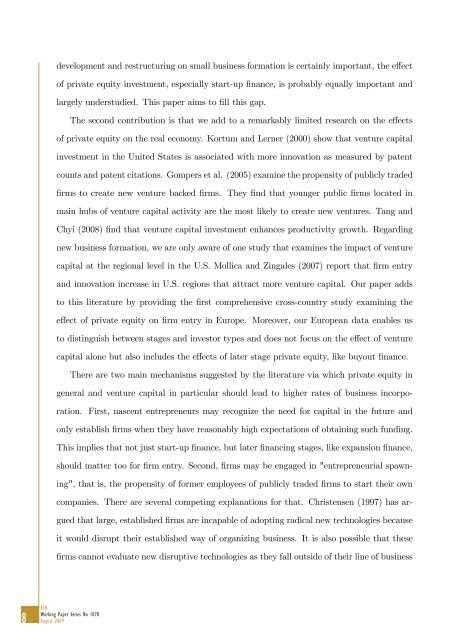On the real effects of private equity investment: evidence from new ...
On the real effects of private equity investment: evidence from new ...
On the real effects of private equity investment: evidence from new ...
- No tags were found...
You also want an ePaper? Increase the reach of your titles
YUMPU automatically turns print PDFs into web optimized ePapers that Google loves.
development and restructuring on small business formation is certainly important, <strong>the</strong> e¤ect<strong>of</strong> <strong>private</strong> <strong>equity</strong> <strong>investment</strong>, especially start-up …nance, is probably equally important andlargely understudied. This paper aims to …ll this gap.The second contribution is that we add to a remarkably limited research on <strong>the</strong> e¤ects<strong>of</strong> <strong>private</strong> <strong>equity</strong> on <strong>the</strong> <strong>real</strong> economy. Kortum and Lerner (2000) show that venture capital<strong>investment</strong> in <strong>the</strong> United States is associated with more innovation as measured by patentcounts and patent citations. Gompers et al. (2005) examine <strong>the</strong> propensity <strong>of</strong> publicly traded…rms to create <strong>new</strong> venture backed …rms. They …nd that younger public …rms located inmain hubs <strong>of</strong> venture capital activity are <strong>the</strong> most likely to create <strong>new</strong> ventures. Tang andChyi (2008) …nd that venture capital <strong>investment</strong> enhances productivity growth. Regarding<strong>new</strong> business formation, we are only aware <strong>of</strong> one study that examines <strong>the</strong> impact <strong>of</strong> venturecapital at <strong>the</strong> regional level in <strong>the</strong> U.S. Mollica and Zingales (2007) report that …rm entryand innovation increase in U.S. regions that attract more venture capital. Our paper addsto this literature by providing <strong>the</strong> …rst comprehensive cross-country study examining <strong>the</strong>e¤ect <strong>of</strong> <strong>private</strong> <strong>equity</strong> on …rm entry in Europe. Moreover, our European data enables usto distinguish between stages and investor types and does not focus on <strong>the</strong> e¤ect <strong>of</strong> venturecapital alone but also includes <strong>the</strong> e¤ects <strong>of</strong> later stage <strong>private</strong> <strong>equity</strong>, like buyout …nance.There are two main mechanisms suggested by <strong>the</strong> literature via which <strong>private</strong> <strong>equity</strong> ingeneral and venture capital in particular should lead to higher rates <strong>of</strong> business incorporation.First, nascent entrepreneurs may recognize <strong>the</strong> need for capital in <strong>the</strong> future andonly establish …rms when <strong>the</strong>y have reasonably high expectations <strong>of</strong> obtaining such funding.This implies that not just start-up …nance, but later …nancing stages, like expansion …nance,should matter too for …rm entry. Second, …rms may be engaged in "entrepreneurial spawning",that is, <strong>the</strong> propensity <strong>of</strong> former employees <strong>of</strong> publicly traded …rms to start <strong>the</strong>ir owncompanies. There are several competing explanations for that. Christensen (1997) has arguedthat large, established …rms are incapable <strong>of</strong> adopting radical <strong>new</strong> technologies becauseit would disrupt <strong>the</strong>ir established way <strong>of</strong> organizing business. It is also possible that <strong>the</strong>se…rms cannot evaluate <strong>new</strong> disruptive technologies as <strong>the</strong>y fall outside <strong>of</strong> <strong>the</strong>ir line <strong>of</strong> business8ECBWorking Paper Series No 1078August 2009















